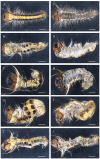Genome Editing of Wnt-1, a Gene Associated with Segmentation, via CRISPR/Cas9 in the Pine Caterpillar Moth, Dendrolimus punctatus
- PMID: 28111552
- PMCID: PMC5216022
- DOI: 10.3389/fphys.2016.00666
Genome Editing of Wnt-1, a Gene Associated with Segmentation, via CRISPR/Cas9 in the Pine Caterpillar Moth, Dendrolimus punctatus
Abstract
The pine caterpillar moth, Dendrolimus punctatus, is a devastating forest pest. Genetic manipulation of this insect pest is limited due to the lack of genomic and functional genomic toolsets. Recently, CRISPR/Cas9 technology has been demonstrated to be a promising approach to modify the genome. To investigate gene functions during the embryogenesis, we introduced CRISPR/Cas9 system in D. punctatus to precisely and effectively manipulate gene expressions inmutant embryos. Compared to controls, knocking out of DpWnt-1, a gene well known for its role in the early body planning, led to high embryonic mortality. Among these mutants, 32.9% of the embryos and larvae showed an abnormal development. DpWnt-1 mutants predominantly exhibited abnormal posterior segments. In addition, multiple phenotypes were observed, including the loss of limbs and the head deformation, suggesting that DpWnt-1 signaling pathway is necessary for anterior segmentation and appendage development. Overall, our results demonstrate that CRISPR/Cas9 system is feasible and efficient in inducing mutations at a specific locus in D. punctatus. This study not only lays the foundation for characterizing gene functions in a non-model species, but also facilitates the future development of pest control alternatives for a major defoliator.
Keywords: CRISPR/Cas9; Dendrolimus punctatus; Wnt-1; embryogenesis; genome editing; segmentation.
Figures







Similar articles
-
CRISPR/Cas9 mediated knockout of the abdominal-A homeotic gene in fall armyworm moth (Spodoptera frugiperda).PLoS One. 2018 Dec 6;13(12):e0208647. doi: 10.1371/journal.pone.0208647. eCollection 2018. PLoS One. 2018. PMID: 30521608 Free PMC article.
-
Complete mitochondrial genome of Simao pine caterpillar moth, Dendrolimus kikuchii (Lepidoptera: Lasiocampidae) and the related phylogenetic analysis.Mitochondrial DNA B Resour. 2017 Sep 5;2(2):611-612. doi: 10.1080/23802359.2017.1372725. Mitochondrial DNA B Resour. 2017. PMID: 33490468 Free PMC article.
-
Functional analysis of Bombyx Wnt1 during embryogenesis using the CRISPR/Cas9 system.J Insect Physiol. 2015 Aug;79:73-9. doi: 10.1016/j.jinsphys.2015.06.004. Epub 2015 Jun 9. J Insect Physiol. 2015. PMID: 26070541
-
Gene Editing in Clinical Practice: Where are We?Indian J Clin Biochem. 2019 Jan;34(1):19-25. doi: 10.1007/s12291-018-0804-4. Epub 2019 Jan 1. Indian J Clin Biochem. 2019. PMID: 30728669 Free PMC article. Review.
-
Applications of the CRISPR-Cas9 system in kidney research.Kidney Int. 2017 Aug;92(2):324-335. doi: 10.1016/j.kint.2017.01.037. Epub 2017 Apr 20. Kidney Int. 2017. PMID: 28433382 Review.
Cited by
-
The organizing role of Wnt signaling pathway during arthropod posterior growth.Front Cell Dev Biol. 2022 Aug 5;10:944673. doi: 10.3389/fcell.2022.944673. eCollection 2022. Front Cell Dev Biol. 2022. PMID: 35990604 Free PMC article. Review.
-
CRISPR/Cas9-Based Genome Editing of Fall Armyworm (Spodoptera frugiperda): Progress and Prospects.Biomolecules. 2024 Aug 27;14(9):1074. doi: 10.3390/biom14091074. Biomolecules. 2024. PMID: 39334840 Free PMC article. Review.
-
Progress and Prospects of CRISPR/Cas Systems in Insects and Other Arthropods.Front Physiol. 2017 Sep 6;8:608. doi: 10.3389/fphys.2017.00608. eCollection 2017. Front Physiol. 2017. PMID: 28932198 Free PMC article. Review.
-
Manipulation of a New Non-model Insect Genome Using Targeted CRISPR-Era Approaches.Methods Mol Biol. 2025;2935:335-384. doi: 10.1007/978-1-0716-4583-3_15. Methods Mol Biol. 2025. PMID: 40828286
-
Biotechnology and Solutions: Insect-Pest-Resistance Management for Improvement and Development of Bt Cotton (Gossypium hirsutum L.).Plants (Basel). 2023 Dec 4;12(23):4071. doi: 10.3390/plants12234071. Plants (Basel). 2023. PMID: 38068706 Free PMC article.
References
LinkOut - more resources
Full Text Sources
Other Literature Sources

